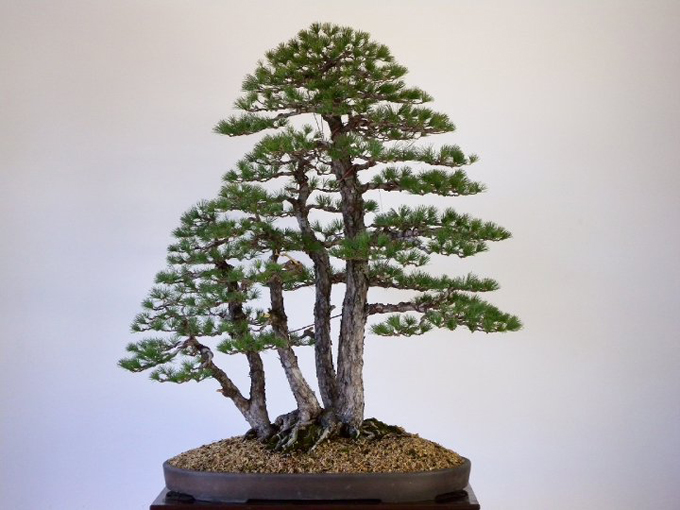 Super Mario is at it again. From Mario Komsta’s facebook photos.
Super Mario is at it again. From Mario Komsta’s facebook photos.
How many trunks can you count?
Does this magnificent tree have four or five trunks? Does it even matter? Actually, I think most of us would say that it does matter and that even though there are only four trunks at ground level, the effect, thanks to the tree on the left, is that of five trunks.
What’s the big deal about even numbers?
Generally, the Japanese abhor the number four, at least when it come to trunks in bonsai. The same can be said for six, eight and ten, though the more trunks there are, the less the number seems to matter (interestingly, two trunks doesn’t seem to bother them, as long as one is clearly stronger than the other).
In general, we seemed to have adopted the Japanese aversion to even numbers when it comes to trunks. To most of us, this convention makes sense. Aren’t threes and fives more dynamic than fours or sixes? Still, you might wonder just how much this convention reflects a genuine principle and how much it simply reflects a cultural preference.
What about nature?
I just had an imaginary conversation with our Mother (Nature, that is). Wanted to double check with her to see if she cared how many trunks there are in a stand of trees. Not surprisingly, she said she never gives it a thought.
 Before. Apologies to Mario Komsta (who happens to be a very talented and accomplished bonsai artist). That’s an almost half-Mario on the right; just to give you a little perspective (though it’s hard to tell exactly how far behind the tree he is). You can go here if you’d like to see the original photo with a full-Mario.
Before. Apologies to Mario Komsta (who happens to be a very talented and accomplished bonsai artist). That’s an almost half-Mario on the right; just to give you a little perspective (though it’s hard to tell exactly how far behind the tree he is). You can go here if you’d like to see the original photo with a full-Mario.
Wayne, wish you (and most others ) would more often ID the species. Maybe it is obvious to others.
Hi Tom,
I often do ID the species. In this case however, I couldn’t find it.
Well,
It’s obviously either scots or Japanese white.
This comes back to that old “Naturalistic” argument about how low down must a double trunk be to actually be a double(or multi) trunk. Please see all info
About Walter Palls wonderful palmatum. I see 5 trunks with the 4th tree becoming 2 trunks above the surface. You can’t have it both ways Wayne…use one Japanese rule about trunks and another about numbers to disprove one another. As to Mario, it’s a great planting.
They both look to me like Japanese white pines, Pinus parviflora.
There’s evidence to support my earlier guess. The caption on the “go here if you’d like to see the original photo” linked page says “pino goyo multi”. The Japanese name for Pinus parviflora is “goyo matsu”.
Hi Ryan,
I hope I didn’t create too much confusion with this post. I wasn’t really trying to have it both ways. Just make some observations and raise some questions.
Agreed, it’s great planting.
Thanks Will,
I think you’ve got it!
-w
This planting juggles my eyes quite a bit. If I look a the trunks below the “Y” I am unsatisfied and dislike the planting…but if my eye moves above the “Y” its quite beautiful. The juggling occurs because the Y creates an arrow pointing my eye downward toward the four trunks, but is bored with the pattern of four and moves back up into the more visually interesting part of the planting and five trunks.
The choice of front is brilliant though…in the finished photograph, the second tallest tree is placed behind the tallest trunk so that they appear to be “one” trunk. It is not until you get above the “Y” of the smallest tree, that you begin to see a separation between the tallest and second tallest tree. In effect making the trunks below the Y seem more like 3 trees and above the Y as five trees. If the negative space between the tallest and second tallest tree came all the way down to the soil it would change the “success” of this planting.
Hi Matt,
Yeah, I tried looking at it from different perspectives too. IAnd agreed, if you block only the very base of the trunks, it does look like a three tree planting.
Overall, I like it a lot, no matter how I chose to look at it.